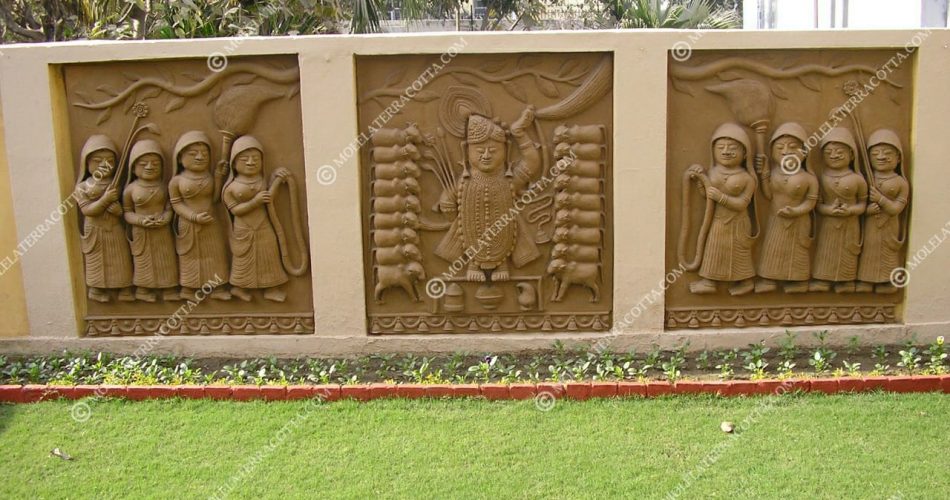Molela Clay work art or terracotta craft is maybe the earliest of man’s creations and marks its coming back archaic. it’s like man sweet-faced the character and he was stirred by its challenges. Moulded out of the world itself, he needed to increase the boundaries of his material existence by expressing his inventive spirit. therefore he took the world in his hand and commenced to fashion an entire new world of infinite shapes of grace and magnificence.
The history of the art has been a fine-looking journey in the Indian context and a lot of states have contributed to form it richer Rajasthan terracotta tradition, geological dating back to the Indus valley civilization boasts of its distinctive art designs. Molela village in Rajsamand district has been a witness of the development of turning clay into objects of worship by its potters also known as Molela clay work art, transfer associate degree intimacy with faith and belief woven into existence, a practice, that has till recently, been unchanged in an exceedingly millennium.
Molela village has emerged as a concentration of the art of creating enticing dedicated, plaques or idols of gods with terracotta. Whereas the first creations were originally standing idols of native deities and numerous Vishnu forms with complete handmade molela clay work art. However Nowadays, these figures are typically mounted on tiles or plaques and are decorated from the walls of temples and houses.
These votive will be multicolored or will have a terracotta hue, as will be seen in numerous temples in Rajasthan and Gujarat. Whereas the potters of Molela clay work art are illustrious for manufacturing the non-secular dedicated vogue or idols, they additionally procure their support from these, however currently a day they additionally depict scenes that express what the artisans will see in his/her surroundings on plaques. Like most crafts, the standard form has been passed from generation to generation, through the sons of the family, evolving with every generation.
Molela Clay Work Art | Demand of the Products
Once a year during January, various tribal groups visit Molela. Each group is accompanied by a priest (bhopa) who helps to choose the appropriate image of a particular god crafted in Molela clay work art. While in trance, the priest leads the procession to a nearby river, where the deity is worshipped before returning home for installation in the shrine, accompanied by feasting, ceremonies, and prayers. It is traditional to change the votive plaques every three to five years. Customers usually purchase several, many depicting the same god.
These are installed in a row in village shrines, where they are worshipped on festival days and for the alleviation of illness and other misfortune. But recently these potters have also been noticed by architects and decorators and have gained much prominence. Their art and craft is being used to decorate the walls of urban Indian homes, farmhouses and corporate offices.
This exposure has also helped them to interact with the Western market and they have demonstrated their production techniques in America, Europe and Japan. The demand has also had an effect on the style of their work. The potters often make large plaques and instead of the traditional images they often depict local scenes of everyday life.
Of the few change that had impacted the molela clay work art craft of the village, the major one took place in the year 1981 when the Aditi-India Festival was arranged. The senior most craftsman Mohanlal recollects, “prior to that, none of us made anything other than traditional subject like local deities, folks heroes and clay pots and kitchen vessels.
But when the Aditi exhibition organizers met us in connection with the series of wall panels entitled ‘Fair Time’ for the festival, the size as well as the subject matter of our plaques had undergone major changes. They especially a lady member encouraged us to try something different from our tradition subject matter and other than usual votive images, like what we see daily around us in the village using molela clay work art.
Accordingly we shaped various square tiles depicting scenes of day to day life in the village witch were arranged in a single large panel”. Those panels gave birth to the contemporary – secular plaques out of Molela clay work. Subsequently these strikingly variant panels also led to reworking of traditional subjects by jumbling together of various unrelated gods, goddesses, folk heroes and symbols into one single panel.
The changes among the youngsters in the post-independent period are of two types.
- Among those educated youngsters who were after white collar jobs or wage employment, a few dared to leave their village or their hereditary craft.
- The other youths while carrying on their traditional craft never hesitated to innovate and introduce new artefacts including utilities.
We are now also accepting the custom order with custom designs to enhance Molela clay work.
